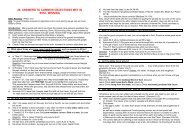92. EVIDENCE FOR CREATION in 6 DAYS in 4074 BC - Answers
92. EVIDENCE FOR CREATION in 6 DAYS in 4074 BC - Answers
92. EVIDENCE FOR CREATION in 6 DAYS in 4074 BC - Answers
You also want an ePaper? Increase the reach of your titles
YUMPU automatically turns print PDFs into web optimized ePapers that Google loves.
26. Most b<strong>in</strong>ary stars circl<strong>in</strong>g one another are of different composition. Big Bang theory can’t<br />
expla<strong>in</strong> this.<br />
27. Stars with<strong>in</strong> globular clusters ought to be all crash<strong>in</strong>g <strong>in</strong>to one another if any nonth<strong>in</strong>k<strong>in</strong>g<br />
force brought them together, but they are not.<br />
28. Stars never get closer than 3.5 light years apart. Would randomness produce this? No.<br />
29. Stellar evolution is non-observable. Stars are not evolv<strong>in</strong>g <strong>in</strong> space. Plants and<br />
animals are not evolv<strong>in</strong>g on earth.<br />
30. The sun would have to sp<strong>in</strong> extremely fast to hurl off planets and moons, yet it rotates<br />
very slowly.<br />
31. Big Bang theory cannot expla<strong>in</strong> where stars, planets and moons orig<strong>in</strong>ated, nor how<br />
they arrived at their present precise, <strong>in</strong>tricate orbits. How could every moon be located<br />
at the precise distance to keep it from fly<strong>in</strong>g <strong>in</strong>to or away from its planet, from a Big<br />
Bang explosion?<br />
32. Uranus and Venus rotate backward compared to all the other planets. The other 7 rotate<br />
forward.<br />
33. One third of the 60 moons rotate opposite to the rotational direction of their planets.<br />
Why?<br />
34. Our planets and moons are so strik<strong>in</strong>gly different that they could not have orig<strong>in</strong>ated<br />
from the same Big Bang source. “If you look at all the planets and the 60 or so satellites<br />
(moons), it’s very hard to f<strong>in</strong>d two that are the same.” (Ross Taylor of ANU Canberra, <strong>in</strong><br />
“The Solar Systems New Diversity”, Richard Kerr, Science 265, 2 Sep 1994, p.1360).<br />
35. The chemical makeup of Earth’s moon and Earth are dist<strong>in</strong>ctly different, imply<strong>in</strong>g that<br />
the moon formed under different conditions.<br />
36. Nearly all of Saturn’s 17 moons are extremely different. It has 3 sets of moons shar<strong>in</strong>g<br />
the same orbit. Some moons travel clockwise, others travel anti-clockwise. The surface<br />
of Iapetus is 5 times darker on one side than the other. Hyperion is potato shaped.<br />
Enceladus has an extremely smooth surface, whereas other moons are much rougher.<br />
Why? Titan’s atmosphere is thicker than earth’s.<br />
How could all these moons orig<strong>in</strong>ate by chance?<br />
Elemental Forces of the Universe.<br />
37. Gravity Force is perfectly balanced.<br />
a) If gravity were stronger, smaller stars could not form.<br />
b) If gravity were weaker, bigger stars could not form, no heavy elements could exist,<br />
only dwarf stars would exist, which would radiate light too feebly to support life.<br />
38. Proton/Neutron mass ratio<br />
The neutron mass can only exceed the proton mass by twice the electron’s mass (About 1<br />
part per 1000).<br />
a) If the proton to neutron mass ratio were less, atoms would fly apart.<br />
b) If the proton to neutron mass ratio were greater, atoms would crush together, quickly<br />
decay<strong>in</strong>g <strong>in</strong>to a neutron, positron and neutr<strong>in</strong>o, thus destroy<strong>in</strong>g hydrogen, the ma<strong>in</strong><br />
element <strong>in</strong> the universe.<br />
The Master Designer planned that the proton’s mass would be slightly smaller than a<br />
neutron’s mass, otherwise the universe would collapse. If protons decayed, the universe<br />
would collapse.<br />
39. Photon mass to Baryon mass ratio.<br />
If this ratio were higher, stars and galaxies could not hold together by gravitational<br />
attraction.<br />
40. Nuclear force holds an atom together.<br />
a) If it were smaller, there would only be hydrogen and no heavier elements.<br />
b) If it were larger, there would be no hydrogen but only heavier elements. With no<br />
hydrogen there would be no stable stars, and no life.<br />
c) If it were 1% weaker or stronger, carbon could not exist, nor could life exist.<br />
d) If it were 2% stronger, protons could not exist.<br />
41. Electromagnetic Force <strong>in</strong> an atom b<strong>in</strong>ds negative charged electrons to a positively charged<br />
nucleus<br />
a) If it were smaller or larger, no chemical bonds could form.<br />
b) If the electron charge were 3 times larger, no element could exist other than<br />
hydrogen.<br />
c) If the electron charge were one-third as large, all neutral atoms would be destroyed<br />
by the lowest heat-such as is found <strong>in</strong> outer space.<br />
Conclusion: It would be impossible for evolution to produce the correct balance of these<br />
forces. They were planned. These 4 basic forces (gravitational, electromagnetic, weak and<br />
strong nuclear forces) differ so greatly <strong>in</strong> strength, that the strongest is 10 40 times stronger<br />
than the weakest of them. Yet Big Bang theory mathematics requires that all basic forces<br />
had to be the same strength before and just after the Big Bang Explosion occurred.<br />
Evolutionists cannot claim that these precise, delicate balances of forces occurred by<br />
“natural selection”, or “mutations”, for we are here deal<strong>in</strong>g with the basic properties of<br />
matter. There is no room for gradual “evolv<strong>in</strong>g”. The proton-neutron mass ratio has always<br />
been the same. It will not change. It began just right. There was no second chance. This<br />
applies to all the other forces and balances <strong>in</strong> elemental matter and the laws of physics<br />
govern<strong>in</strong>g them.<br />
If you open a typical science book on astronomy, you will f<strong>in</strong>d theories about the orig<strong>in</strong> of<br />
the universe and stars stated with great certa<strong>in</strong>ty to the public.<br />
By 1970, so much scientific data had repudiated the basic aspects of various cosmologies,<br />
that <strong>in</strong> April 1972, the top m<strong>in</strong>ds <strong>in</strong> stellar physics, chemistry and astronomy gathered at the<br />
Nice Symposium to resolve: a) How did the first cloud break apart and change <strong>in</strong>to stars?<br />
b) How did the gas clouds whirl to form stellar objects to solve the angular momentum<br />
problem?<br />
c) How did the gas push itself <strong>in</strong>to solids?<br />
d) How did the planets, with their present properties and solar distances form?<br />
If you attend such a closed-door conference, you will f<strong>in</strong>d worried men, desperate theories,<br />
scientific facts condemn<strong>in</strong>g these theories, a lack of alternative explanations, an<br />
atmosphere of hopeless despair <strong>in</strong> the face of unproven ideas, and no solutions or scientific<br />
experiments to alleviate the situation.<br />
Key: The problem is that evolutionists do not want the public to know that scientists cannot<br />
figure out how galaxies, stars and planets orig<strong>in</strong>ated.<br />
17. SCIENTISTS SPEAK AGAINST EVOLUTION<br />
1) “In spite of nearly a century of work and discussion there is still no unanimity <strong>in</strong> regard to<br />
the details of the means of evolution”. R. Goldschmidt, “Evolution viewed by one<br />
Geneticist”, “American Scientist, Vol. 409, Jan 1952, p.84<br />
2) “Evolution is baseless and quite <strong>in</strong>credible”. (Ambrose Flemm<strong>in</strong>g, President of British<br />
Association for Advancement of Science).<br />
3) “Today our duty is to destroy the myths of evolution. Some refuse to acknowledge the<br />
<strong>in</strong>adequacies and falsity of their beliefs”. (Pierre-Paul Grasse).<br />
4) “Scientists who go about teach<strong>in</strong>g that evolution is a fact of life are great con men, and<br />
the story they are tell<strong>in</strong>g may be the greatest hoax ever.” (T.N. Tahmisian, Physiologist for<br />
the Atomic Energy Commission, quoted <strong>in</strong> Fresno Bee, 20 Aug. 1959).





